Assamese cuisine is based on the use of local ingredients, including rice, fish, meat, and vegetables. The cuisine is characterized by its use of simple cooking techniques, with a focus on preserving the natural flavors of the ingredients. The food of Assam is generally less spicy than other Indian cuisines, with a focus on herbs and aromatic spices.
Variety of Jolpan: Traditional Breakfast Snacks from Assam
Jolpan is a traditional breakfast dish from Assam, a state in Northeast India. It is typically served in the morning with a cup of hot Assam tea. Jolpan is a combination of different snacks and sweets, and can vary in ingredients and preparation from region to region in Assam. Here are some of the most popular types of jolpan from Assam:
- Chira: Chira is a flaked rice that is commonly used in jolpan. It is usually soaked in water, and then served with jaggery and milk.
- Pitha: Pitha is a type of rice cake that is often served as part of jolpan. It can be sweet or savory and can be prepared in a variety of ways, including steaming, frying, or baking.
- Kholasapori Pitha: Kholasapori Pitha is a type of rice cake that is popular in the Kholasapori region of Assam. It is made with a mixture of rice flour and jaggery and is often served with tea.
- Ladoo: Ladoo is a type of sweet made from flour, sugar, and ghee. It is a popular jolpan snack and is often served during festivals and other special occasions.
- Ghila Pitha: Ghila Pitha is a type of rice cake that is steamed in banana leaves. It is made from a mixture of rice flour and coconut, and is a popular jolpan item in Assam.
- Narikol Pitha: Narikol Pitha is a coconut-stuffed rice cake that is steamed in banana leaves. It is a popular jolpan item in Assam and is often served with tea.
- Muri: Muri is a puffed rice that is commonly used in jolpan. It is usually served with milk and sugar, and is a light and crunchy breakfast option.
These are just a few examples of the many different types of jolpan that are enjoyed in Assam. Each type has its own unique flavor and preparation method, and all are an important part of Assamese cuisine and culture.
Bora Saul: The Nutritious and Delicious Black Rice of Assam
Bora Saul is a unique variety of black rice that is grown in the Northeastern state of Assam, India. It is a traditional staple food in Assamese cuisine and is known for its unique flavor, nutritional benefits, and cultural significance. The rice has a distinctive dark color and a nutty taste, which makes it a popular ingredient in a variety of dishes, including pitha (rice cake), pulao (rice pilaf), and kheer (rice pudding).
Bora Saul is rich in antioxidants and nutrients, including iron, magnesium, and fiber, and has been associated with a number of health benefits, such as reducing inflammation, improving heart health, and promoting healthy digestion.
In Assam, Bora Saul is more than just a food; it is deeply rooted in the state’s culture and traditions. It is often served at special occasions and religious festivals, and is considered a symbol of prosperity, good health, and community.
Overall, Bora Saul is a unique and nutritious ingredient that adds flavor, health benefits, and cultural significance to Assamese cuisine.
Komal Saul: The Lesser-Known But Delicious White Rice of Assam
Komal Saul is a variety of white rice that is primarily cultivated in the Northeastern state of Assam, India. Although it is not as well-known as other varieties of rice, it is a delicious and nutritious staple food in Assamese cuisine.
Komal Saul has a unique flavor and texture that sets it apart from other types of rice. It is slightly sweet and has a soft, fluffy texture when cooked. This makes it an ideal ingredient for a variety of dishes, including steamed rice, pulao, and kheer.
In terms of nutrition, Komal Saul is a good source of carbohydrates, fiber, and protein. It also contains essential vitamins and minerals, such as thiamin, niacin, and iron. These nutrients are important for maintaining good health and preventing deficiencies.
While Bora Saul is more well-known, Komal Saul also plays an important role in the food culture of Assam. It is often used in traditional dishes, and is sometimes served as a part of a thali, which is a platter of different dishes that are served together.
Overall, Komal Saul is a delicious and nutritious rice that is worth trying for anyone interested in exploring the diverse and delicious food culture of Assam.
Chira: The Traditional Flattened Rice of Assam
Chira is a traditional breakfast food in the Indian state of Assam, and is a popular ingredient in Assamese cuisine. Also known as poha or flattened rice, Chira is made by parboiling rice, then flattening and drying it.
Chira has a light, crispy texture, and is commonly used in dishes such as chira doi (curd with flattened rice), chira polao (flattened rice pilaf), and chira upma (flattened rice cooked with vegetables). It is often eaten with curd, milk, jaggery, or other sweeteners to add flavor and texture.
In terms of nutrition, Chira is a good source of carbohydrates, fiber, and B vitamins, and is low in fat and cholesterol. It is also easy to digest and quick to cook, making it an ideal breakfast food.
Chira is deeply ingrained in Assamese culture and is often served at festivals, religious ceremonies, and special occasions. It is an important part of the food culture of Assam, and is a beloved comfort food for many.
Overall, Chira is a versatile and nutritious ingredient that adds flavor and texture to a variety of Assamese dishes, and is an important part of the state’s food culture.
Muri: The Light and Crunchy Puffed Rice Snack of Assam
Muri is a popular snack in the Indian state of Assam, and is made by heating rice grains in hot sand until they pop and puff up. It is a light, crunchy and delicious snack that is often enjoyed as a tea-time snack, especially during the monsoon season when it is readily available.
Muri can be eaten as is, or can be mixed with other ingredients like peanuts, roasted gram, onions, tomatoes, chilies, and spices to make a savory snack mix. It can also be made into a sweet snack by adding jaggery or sugar.
Apart from being a tasty snack, Muri is also a popular ingredient in many Assamese dishes. It is often used as a topping in dishes like pitha (Assamese rice cake), and as a stuffing in rolls and breads.
In terms of nutrition, Muri is low in calories and fat, and is a good source of carbohydrates and fiber. It is also easy to digest, making it a popular snack for people of all ages.
Muri has been a part of Assamese food culture for generations, and is deeply ingrained in the state’s culinary traditions. It is a beloved snack that is enjoyed by people all over Assam, and is an important part of the region’s food heritage.
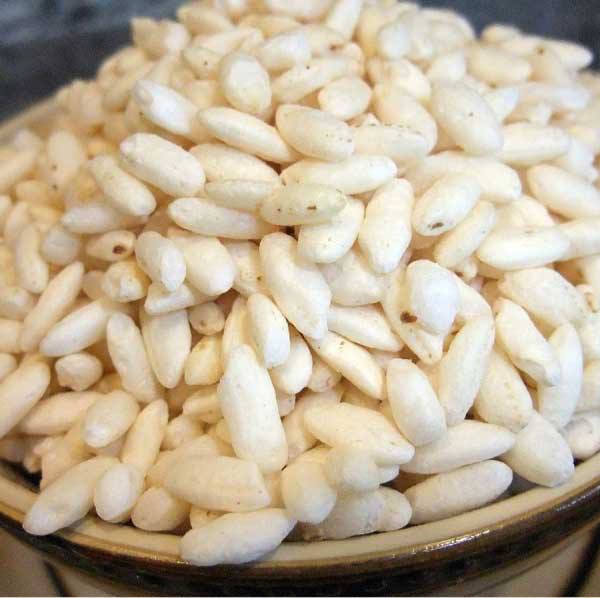
Xandoh Guri: A Flavorful Spice Mix Used in Assamese Cuisine
Xandoh Guri is a traditional spice mix that is commonly used in Assamese cuisine. It is made by dry roasting a variety of whole spices such as coriander seeds, cumin seeds, fennel seeds, and mustard seeds, and then grinding them into a fine powder. The mixture is then mixed with powdered dried lemon leaves or black cardamom for added flavor and aroma.
Xandoh Guri is known for its pungent and aromatic flavor, and is used in a variety of Assamese dishes, particularly fish and meat dishes. It is also used as a seasoning for stir-fried vegetables, lentils, and stews. The spice mix is particularly popular in rural areas of Assam, where it is often used as a substitute for garlic and onion, which are not commonly used in traditional Assamese cuisine.
Apart from its culinary uses, Xandoh Guri also has medicinal properties. It is believed to aid digestion, improve appetite, and alleviate respiratory problems.
Xandoh Guri is an important part of Assamese food culture, and is a staple in many households in the region. Its unique flavor and versatility make it a popular ingredient in many Assamese dishes, and it is a must-try for anyone interested in exploring the rich and diverse cuisine of Assam.

Sunga Saul: The Fragrant and Nutritious Barnyard Millet of Assam
Sunga Saul is a type of millet that is native to Assam and other parts of India. It is also known as barnyard millet due to its resemblance to the seeds of barnyard grass. Sunga Saul is a staple food in Assam and is used to make a variety of dishes, including porridge, cakes, and bread.
Dehusked Aroi bora saul is soaked for two hours. Then it’s put in an immature bamboo tube and somewhat water or typically coconut milk is added to it. Banana leaf is used as cork. The tube is roasted in a hearth, and Sunga Saul is ready. Upon removing the tube, the substance is served with curd, scorching milk, yogurt, sugar, and so forth.
Sunga Saul is highly nutritious and is rich in protein, fiber, and essential vitamins and minerals. It is also gluten-free, making it an ideal choice for people with gluten intolerance. The millet has a mild and slightly nutty flavor, and a distinctive aroma that is similar to that of popcorn.
In addition to its culinary uses, Sunga Saul is also used in traditional medicine for its medicinal properties. It is believed to aid digestion, reduce inflammation, and improve cardiovascular health.
Sunga Saul is an important part of Assamese cuisine and is an integral part of the region’s food culture. Its unique flavor and nutritional value make it a popular ingredient in many dishes, and it is a must-try for anyone interested in exploring the diverse and delicious cuisine of Assam.
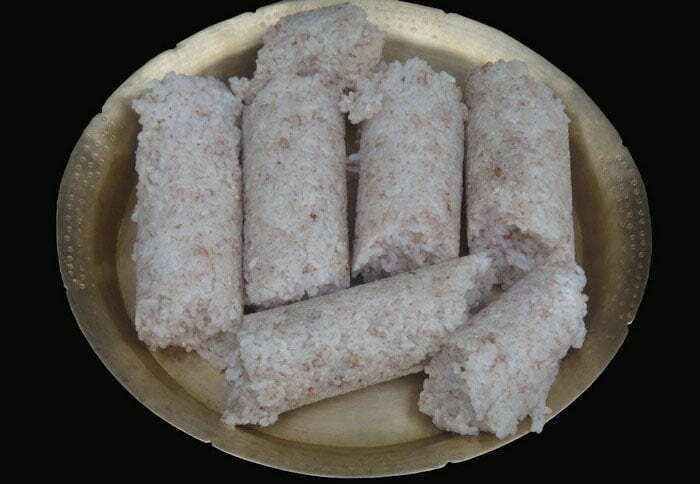
Pithaguri: A Savory and Crunchy Snack from Assam
Pithaguri is a traditional snack from the northeastern state of Assam, India. It is a savory and crunchy snack made from roasted and crushed rice and sometimes mixed with spices such as cumin, coriander, and turmeric. The name “pithaguri” comes from the Assamese words “pitha,” meaning cake, and “guri,” meaning powder.
Pithaguri is a popular snack that is enjoyed in Assam during tea time or as an evening snack. It is often served with hot tea or coffee, and can also be enjoyed on its own as a quick and satisfying snack.
To make pithaguri, rice is first roasted on a low flame until it turns golden brown. Once the rice is roasted, it is then crushed into a fine powder using a stone grinder or a mortar and pestle. The rice powder is then mixed with spices and salt to create the final snack.
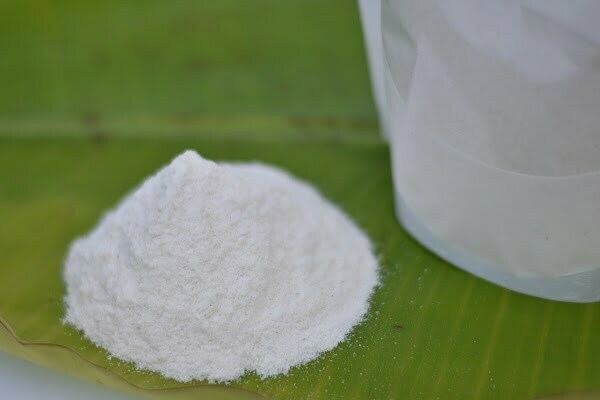
Suji: A Versatile and Nutritious Ingredient in Assamese Cuisine
Suji, also known as semolina, is a popular ingredient in Assamese cuisine. It is a coarsely ground grain made from durum wheat and is a versatile ingredient used in a variety of dishes.
In Assam, suji is used to make a variety of dishes such as suji ka halwa, a sweet and fragrant dessert made with ghee, sugar, and cardamom. It is also used to make upma, a savory breakfast dish made with vegetables, spices, and suji.
Suji is a nutritious ingredient that is rich in carbohydrates, protein, and vitamins B and E. It is also a good source of fiber and helps to regulate blood sugar levels, making it a great option for people with diabetes.
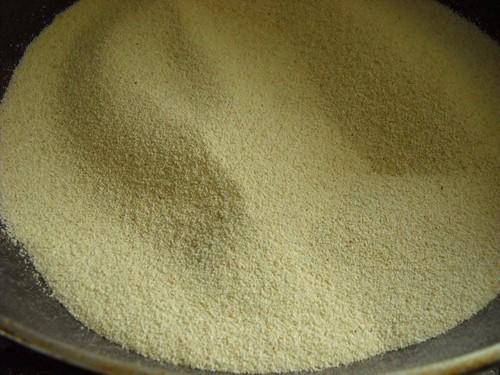
Koni-dhan: The Delicious and Aromatic Black Aromatic Rice of Assam
Koni-dhan, also known as black aromatic rice, is a traditional variety of rice that is grown in the Assam region of India. It is a type of glutinous rice that has a distinct black color and a unique, floral aroma.
Koni-dhan is often used in festive dishes and special occasions such as weddings and religious ceremonies. It is also used to make traditional Assamese desserts such as pitha, a steamed rice cake that is usually filled with sweetened coconut or sesame.
This rice variety is not only delicious but also nutritious. It is rich in antioxidants, fiber, and minerals such as iron and zinc, making it a great addition to a healthy diet.
Koni-dhan is traditionally cultivated by small-scale farmers using organic methods. It is a part of Assamese culture and has been grown in the region for centuries. Today, it is gaining popularity not only in Assam but across India and even internationally.
Overall, Koni-dhan is a delicious and aromatic rice variety that is an important part of Assamese cuisine and culture. Its unique flavor and nutritional benefits make it a great option for those looking to explore new and diverse ingredients in their cooking.
Pitha: The Sweet and Savory Rice Cakes of Assam
Pitha is a traditional rice cake that is popular in Assam and other parts of Northeast India. It is usually made with rice flour, and sometimes with wheat flour or other grains, and is often filled with a variety of sweet or savory fillings.
There are many different types of pitha, each with its own unique flavor and preparation method. Sweet pithas are often filled with coconut, sesame, jaggery (unrefined cane sugar), or sweetened milk, while savory pithas may be filled with vegetables, meat, or fish.
Pithas are typically steamed or fried, and may be shaped into a variety of forms, including round, oval, or cylindrical shapes. Some pithas are also decorated with intricate patterns or designs, which make them as visually appealing as they are delicious.
Pitha is often served during special occasions and festivals, such as Bihu, Magh Bihu, and Assamese New Year. It is a popular snack and is enjoyed by people of all ages. Pitha-making is also an important part of Assamese culture, with recipes and techniques often passed down from generation to generation.
In recent years, pitha has gained popularity outside of Assam and Northeast India, with people from all over the world enjoying the unique flavors and textures of this traditional rice cake.

Til Pitha: The Delicious Sesame Seed Rice Cake of Assam
Til Pitha is a type of pitha that is popular in Assam and other parts of Northeast India. It is made with a mixture of rice flour, sesame seeds, jaggery (unrefined cane sugar), and sometimes coconut. The mixture is then formed into small cakes and fried until crispy and golden brown.
Til Pitha is a sweet and savory treat that is enjoyed during festivals and special occasions, such as Bihu and Magh Bihu. It is often served with a cup of tea or coffee and is a favorite among people of all ages.
The combination of rice flour, sesame seeds, and jaggery gives Til Pitha a unique flavor and texture that is both crunchy and chewy. The addition of coconut, if used, adds a subtle sweetness and a pleasant aroma to the dish.
Til Pitha is easy to make and requires only a few ingredients, making it a popular snack among families in Assam. It is also a great way to introduce people to the traditional flavors of Assamese cuisine and the art of pitha-making.
Ghila Pitha: The Sweet and Soft Pancakes of Assam
Ghila Pitha is a traditional Assamese pancake that is typically made during special occasions and festivals, such as Bihu and Magh Bihu. It is made by mixing rice flour with jaggery (unrefined cane sugar) and grated coconut to form a batter, which is then cooked on a griddle or in a pan.
The batter is poured onto the griddle or pan and spread into a thin pancake. It is then cooked until golden brown on both sides. Ghila Pitha is soft and fluffy, with a slight sweetness from the jaggery and coconut. It is often served as a snack or dessert and is enjoyed by people of all ages.
Ghila Pitha is a versatile dish and can be made with different variations of the batter. For example, some recipes use a combination of wheat flour and rice flour, while others use only rice flour. Some recipes also include mashed bananas or grated carrots to add a natural sweetness and enhance the flavor of the pancake.
Overall, Ghila Pitha is a delicious and comforting pancake that is a staple in Assamese cuisine. Its soft and sweet taste is perfect for anyone with a sweet tooth, and its simplicity makes it a great option for those looking to try their hand at traditional Assamese cooking.
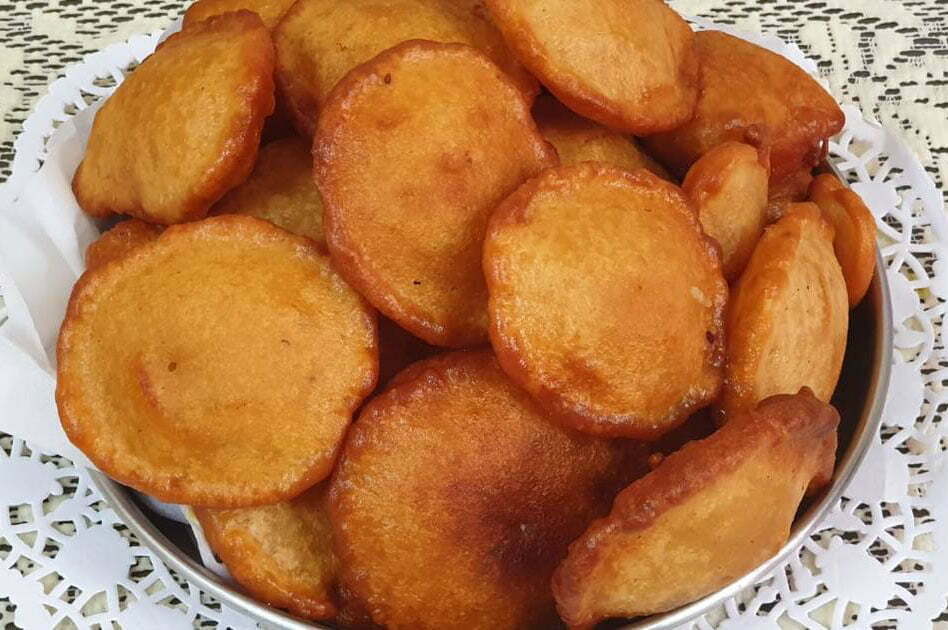
Sunga Pitha: The Delicious and Nutritious Rice Cakes of Assam
Sunga Pitha is a traditional Assamese rice cake that is typically made during Bihu, the major festival of Assam. It is made by grinding soaked rice into a fine paste, which is then mixed with grated coconut and jaggery (unrefined cane sugar) to form a batter. The batter is then poured into cone-shaped leaves from the sunga tree, which is a type of bamboo.
The cone-shaped leaves filled with batter are then steamed until cooked. The result is a soft and spongy rice cake with a slightly sweet and nutty flavor from the coconut and jaggery. The sunga leaves impart a distinct aroma to the rice cake, making it a unique and cherished dish in Assamese cuisine.
Sunga Pitha is a type of traditional Assamese sweet made from a combination of rice flour, water, jaggery, and bamboo. To prepare it, the rice flour of Xaali saul and Bora saul is mixed with water and jaggery and blended thoroughly. The resulting paste is then put into an immature bamboo tube that has been corked with a banana leaf, creating a cylindrical shape.
The bamboo tube is then roasted over a fire until the pitha inside is cooked through. After cooking, the bamboo tube is removed, leaving a solid cylinder of pitha. The pitha is then cut into pieces and served with hot milk, creating a sweet and creamy dessert that is enjoyed throughout Assam.
Uhuwa Pitha: The Sweet and Savory Delight of Assam’s Bihu Festival
Uhuwa Pitha is a traditional Assamese rice cake that is commonly prepared during festivals and special occasions. It is made by soaking black gram lentils (Uhuwa dal) in water for a few hours, then grinding them into a fine paste. This paste is then mixed with soaked rice and salt, and blended to a smooth consistency.
The batter is then poured into a greased mold and steamed until it is fully cooked. Once cooked, the Uhuwa Pitha is removed from the mold and served warm. It has a soft, spongy texture and a slightly savory taste that pairs well with tea or other hot beverages. Uhuwa Pitha is a popular snack in Assam and is enjoyed by people of all ages.
Tekeli Pitha: A Delicious and Unique Assamese Rice Cake Cooked in an Earthenware Pot
Tekeli Pitha is a traditional rice cake from Assam, India, which is cooked in an earthenware pot. It is made from a mixture of rice flour, coconut, sugar, and powdered milk, along with ground cardamom and dried orange rind for flavor.
To make Tekeli Pitha, an earthenware pot is filled halfway with water and placed on a fire. A neat dress is positioned on the beam of the pot, and the flour mixture is put in it. The pot is then covered with a cork, and the heat from the vapor coming from inside the pot cooks the mixture into a cake-like shape. The cake is then cut into pieces and served with tea.
Tekeli Pitha gets its name from the earthenware pot, called a tekeli, which is used to cook it. This traditional Assamese dish is a unique and delicious dessert or snack that is sure to please anyone with a taste for rice-based treats.
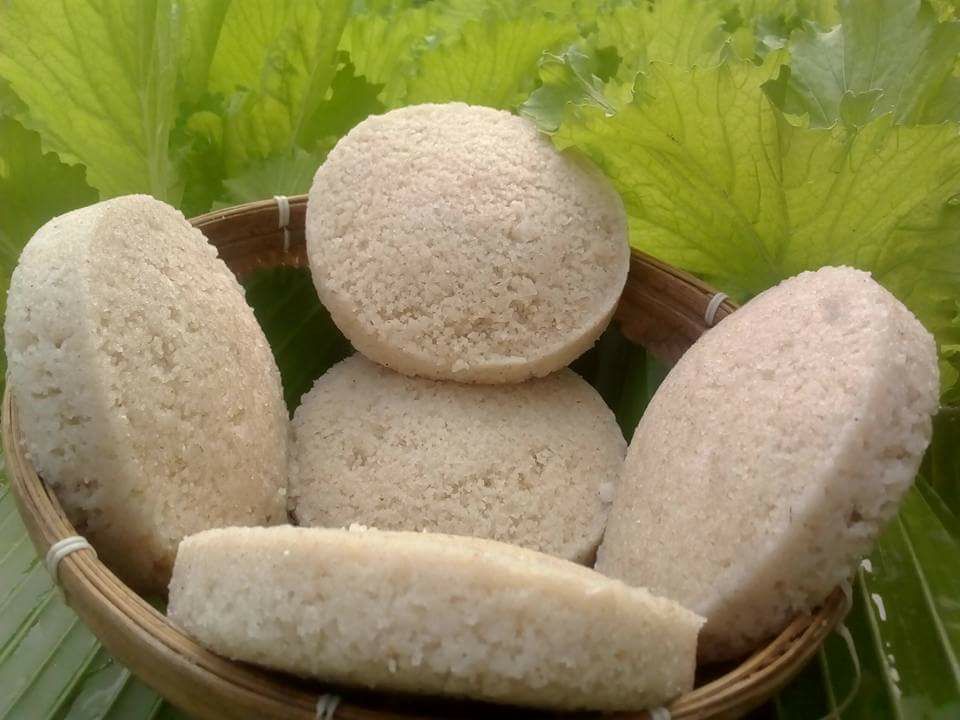
Ladoo: The Sweet and Delicious Ball-Shaped Treat of Assam
Ladoo is a traditional sweet snack that is popular in Assam, as well as other regions of India. It is a type of laddu, a sweet that is made by rolling together various ingredients into small balls or round shapes.
In Assam, Ladoo is typically made using rice flour, jaggery (a type of unrefined sugar), and grated coconut. The ingredients are mixed together and formed into small balls, which are then fried until they turn golden brown in color. The fried balls are then coated in powdered sugar and served as a sweet snack or dessert.
Ladoo is a popular sweet during festivals and special occasions, and is often served as prasad (an offering to the deity) during Hindu religious ceremonies. It is also a popular snack for children and adults alike, and is often packed in lunch boxes or enjoyed as an afternoon snack with tea.
In addition to the traditional Assamese Ladoo, there are many variations of this sweet snack that are found throughout India. Some of the most popular variations include Besan Ladoo (made with chickpea flour), Motichoor Ladoo (made with tiny fried chickpea flour balls), and Til Ladoo (made with sesame seeds).
Coconut Delight: Exploring the Delicious Narikol’or Ladoo of Assam
Narikol Ladoo is a delicious and nutritious sweet that is made from mature coconut, sugar, and a few other ingredients. To make it, the mature coconut is first scraped or ground and then fried until it turns a beautiful golden brown color. Once the coconut is fried, sugar is added and mixed thoroughly. The mixture is then toasted over a slow fire until the sugar caramelizes and the coconut shreds start sticking to each other.
To test the readiness of the mixture, a small ball is made first. If it sticks together, then the mixture is taken off the heat and allowed to cool slightly. The mixture is then rolled into small balls using cold water to prevent the coconut mixture from sticking to the hands. The small balls are then kept separate to dry.
Narikol Ladoo is typically served with tea and is a popular sweet dish in Assam. It is not only delicious but also nutritious, as coconut is a good source of healthy fats and essential nutrients. With its rich flavor and unique texture, Narikol Ladoo is a must-try for anyone interested in exploring the culinary delights of Assam.
Tilor Laru: The Delectable Sesame Sweet Balls of Assam
Tilor laru is a type of sweet that is made using sesame seeds and jaggery. First, the sesame seeds are fried and kept aside. Jaggery, which is a type of sweetener, is heated until it becomes liquid. Then, this liquid jaggery is poured onto the heap of fried sesame seeds. The mixture becomes sticky and is then rolled into small balls. These balls are kept separately to dry. Once they are dry, they can be served with tea. Tilor laru is a popular sweet dish in Assam and is enjoyed by many people as a snack or dessert.
Assam Tea: The Bold and Flavorful Brew of Northeast India
The tea of Assam is a black tea that is grown in the northeastern Indian state of Assam. Assam is one of the world’s largest tea-producing regions, and the tea grown here is known for its strong, robust flavor and bright, malty characteristics.
Assam tea is made from the leaves of the Camellia sinensis plant, which is native to China but was introduced to Assam in the early 19th century. The hot, humid climate and rich soil of the region create ideal growing conditions for the plant, resulting in a tea that is bold and full-bodied with a distinctive flavor.
Assam tea is often enjoyed with milk and sugar and is a popular breakfast tea in many parts of the world. It is also used as a base for chai tea, a spiced tea beverage that is popular in India and other parts of the world.
In addition to being a popular beverage, tea plays an important role in the culture and economy of Assam. The tea industry is a major employer in the state, and many small-scale tea growers and producers operate in the region. The tea gardens of Assam are also a popular tourist attraction, offering visitors a chance to experience the beauty of the tea-growing landscape and learn about the history and culture of tea production in the region.
Assamese traditional drinks
Assam, a state in Northeast India, is home to a rich and diverse culture, which is reflected in its traditional drinks. Here are some of the most popular traditional drinks of Assam:
- Xaj Pani: Xaj Pani is a traditional rice beer that is made from fermented rice. It is a popular drink in rural areas of Assam and is often served during festivals and other special occasions.
- Aapong: Aapong is a traditional rice wine that is made by fermenting rice and jaggery (unrefined sugar). It is a sweet and mild alcoholic beverage that is often served during weddings and other celebrations.
- Pitha Pani: Pitha Pani is a traditional drink that is made by soaking a type of rice cake called pitha in water. The pitha absorbs the water and becomes soft, resulting in a refreshing and nourishing drink.
- Bel Pani: Bel Pani is a drink made from the pulp of the bel fruit, which is a type of tropical fruit that grows in Assam. The pulp is mixed with water and sugar to create a refreshing and cooling drink.
- Kaji Nemu: Kaji Nemu is a traditional drink made from the juice of the kaji lemon, a type of small lemon that is grown in Assam. The juice is mixed with sugar and water to create a refreshing and tangy beverage.
Conclusion:
Assamese cuisine is a unique and diverse culinary tradition that reflects the state’s geographical and cultural diversity. From traditional snacks like Pitha to hearty meals like the Assamese Thali, there are many delicious foods to discover in Assam. The food of Assam is characterized by its use of local ingredients and simple cooking techniques, and the result is a cuisine that is both flavorful and nutritious. Whether you’re a foodie or just looking to explore the culture of Assam, the food of this region is sure to delight and satisfy your taste buds.
For extra details, please click here.










